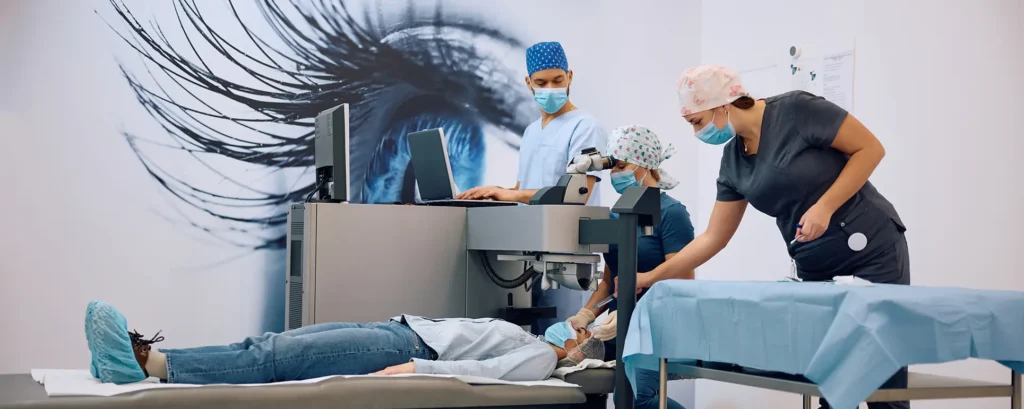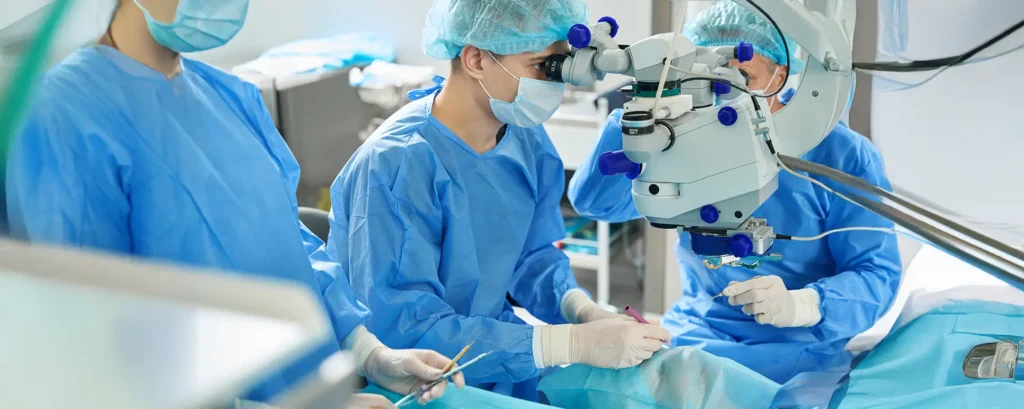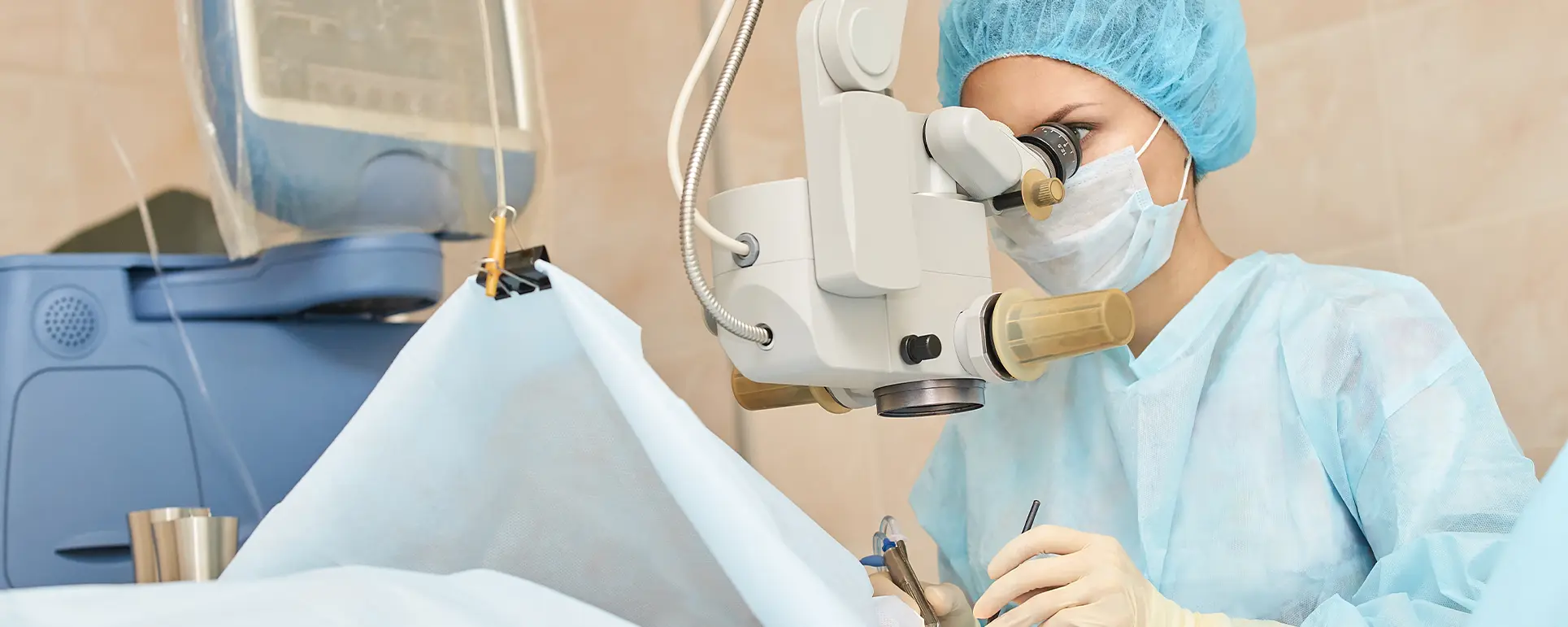Most people think of cataract surgery as a straightforward fix remove the cloudy lens, insert a clear one, and restore vision. For many, that’s absolutely true. But for patients with severe corneal disease, lens replacement alone isn’t enough.
In these complex cases, the problem isn’t just inside the eye it’s also at the surface. The cornea, the transparent front window of your eye, can become so scarred, opaque, or damaged that light can’t pass through clearly, even if the lens behind it is perfect.
That’s where artificial corneas (keratoprostheses) come in. When used alongside or after cataract surgery, they can help restore vision for people once thought untreatable. In this article, we’ll explore when this approach is needed, how the surgeries are coordinated, and what new materials are making these combined treatments more successful than ever.
Understanding Cataract Surgery and Its Limits
Cataract surgery replaces your eye’s natural, clouded lens with an artificial intraocular lens (IOL). It’s one of the safest and most common operations in the world.
But even with a perfect lens, your vision depends on the clarity of your cornea. The cornea focuses incoming light onto your retina. If it’s scarred or damaged, your vision may remain cloudy even after cataract surgery.
In simple terms: the best lens in the world won’t help if the window it’s sitting behind is fogged over. That’s why patients with both cataracts and corneal damage may need more than standard surgery a combined approach that restores clarity to both the lens and the cornea for truly sharp, lasting vision.
When Cataract Surgery Alone Isn’t Enough

You may need more than cataract surgery if you have:
- Severe corneal scarring from injury, infection, or previous surgery.
- Corneal dystrophies, such as Fuchs’ endothelial dystrophy.
- Chemical burns or autoimmune conditions that damage the cornea.
- Failed corneal transplants that can no longer be repeated.
- Severe keratoconus (corneal thinning and distortion).
In these cases, even after cataract removal, light can’t pass efficiently through the front of the eye so additional treatment targeting the cornea becomes essential.
Introducing the Artificial Cornea (Keratoprosthesis)
An artificial cornea, or keratoprosthesis (KPro), is a synthetic device that replaces the damaged natural cornea. It allows light to reach the retina when traditional corneal transplants have failed or are not viable.
Unlike donor corneal tissue, which can be rejected or become cloudy again, an artificial cornea is made from biocompatible materials such as PMMA (polymethyl methacrylate) and hydrogel polymers designed to integrate with eye tissue.
Think of it as a permanent window implant that stays clear and stable for years, even in eyes that have experienced multiple failed grafts.
When Artificial Corneas Are Used with Cataract Surgery
There are two main situations when both surgeries come into play:
1. Sequential Approach
In this method, cataract surgery is performed first, followed by artificial cornea implantation once the eye has healed.
This is suitable when:
- The cornea isn’t completely opaque.
- The cataract removal may improve visibility enough to reassess the corneal damage.
- The surgeon needs to evaluate retinal health before proceeding with a KPro.
2. Combined Procedure (Triple Surgery)
In more advanced cases, cataract extraction, IOL implantation, and keratoprosthesis placement are done together in a single surgery.
This approach is often used for patients with long-term blindness from corneal opacity and cataract, especially after multiple failed transplants.
The advantage? It restores both the clarity of the cornea and the focusing power of the lens in one coordinated step.
How the Procedures Are Coordinated

Performing cataract surgery and artificial cornea implantation together requires meticulous planning and a highly skilled surgical team.
Pre-Surgery Assessment
Before the operation, your eye undergoes:
- Ultrasound biometry to measure the correct lens power.
- OCT scans to assess retina and optic nerve health.
- Corneal topography (if possible) to map the surface.
Because visibility through a scarred cornea is limited, imaging plays a vital role in guiding the surgeon.
During Surgery
- The clouded lens is removed and replaced with a synthetic IOL.
- The damaged cornea is either partially or completely removed.
- The artificial cornea is then inserted and secured, often using biological support tissue (like donor cornea) to stabilise it.
After Surgery
Post-operative care involves close monitoring to prevent infection, inflammation, or pressure buildup. Lifelong antibiotic and anti-inflammatory drops are usually prescribed.
Types of Artificial Corneas Used Today
There are several types of keratoprostheses available, each with unique strengths depending on the condition of the eye.
1. Boston Keratoprosthesis (Boston KPro)
The most widely used artificial cornea globally, the Boston KPro has a central clear optic surrounded by a supporting donor corneal ring.
It’s typically used in patients with multiple failed corneal grafts or severe scarring.
2. Osteo-Odonto-Keratoprosthesis (OOKP)
This highly specialised procedure uses a small piece of tooth and jawbone from the patient to anchor the optical cylinder. It’s reserved for the most severe cases such as chemical burns or Stevens-Johnson syndrome where other options won’t survive.
3. AlphaCor
A flexible hydrogel-based keratoprosthesis made entirely from synthetic material, eliminating the need for donor tissue. It’s biocompatible and reduces the risk of immune rejection.
4. CorNeat KPro (Next-Generation Design)
A newer entrant, the CorNeat KPro uses nano-fibres that encourage tissue integration, allowing the eye’s natural cells to grow into the implant. It represents the future of long-lasting artificial corneal restoration.
Why Material Science Matters
In the past, artificial corneas faced challenges like poor integration, infection, and clouding. Modern biomaterials have changed that.
Today’s keratoprostheses are:
- Biocompatible they don’t trigger rejection.
- Flexible yet strong designed to mimic the cornea’s curvature.
- Transparent and stable ensuring light transmission stays constant.
Materials like titanium mesh, collagen scaffolds, and nanocomposite hydrogels are now being researched to further improve durability and comfort.
Who Is a Candidate for Combined Surgery?
You might be considered for combined cataract and artificial cornea surgery if:
- You have both a cataract and corneal opacity that prevents clear vision.
- You’ve had multiple failed corneal grafts.
- You’re not suitable for another donor transplant due to severe eye surface disease.
- You have a high-risk condition such as an autoimmune disorder or limbal stem cell deficiency.
Your ophthalmologist will evaluate the potential for visual recovery before recommending surgery. Not every case benefits, especially if the retina or optic nerve is damaged.
Benefits of Combining Cataract Surgery and Artificial Cornea Implantation
- Comprehensive restoration: Addresses both corneal opacity and lens clouding.
- Single recovery phase: Healing happens simultaneously, reducing total downtime.
- Improved vision potential: Light transmission and focus are both optimised.
- Better long-term stability: Especially with new-generation synthetic corneas.
For suitable candidates, this approach can offer a genuine second chance at functional sight.
Risks and Challenges
Like any complex eye surgery, risks exist:
- Infection or inflammation.
- Glaucoma or raised eye pressure.
- Device extrusion (rare but serious).
- Retinal detachment or macular oedema.
Careful selection and lifelong follow-up significantly reduce complications. Choosing an experienced surgical centre with advanced facilities such as the London Cataract Centre makes a huge difference to outcomes.
Recovery and Aftercare
Recovery from combined cataract and keratoprosthesis surgery takes longer than standard cataract operations. You’ll need:
- Daily eye drops (antibiotic and steroid).
- Regular check-ups in the first year.
- Special bandage contact lenses to protect the implant.
Vision often improves gradually over weeks to months as the eye adjusts and swelling subsides.
What Patients Can Expect Long-Term
With modern materials and careful maintenance, artificial corneas can last many years. Most patients experience:
- Clearer, sharper vision.
- Improved ability to recognise faces and navigate independently.
- Reduced sensitivity to glare once healing is complete.
However, lifelong care is essential skipping medication or follow-ups can jeopardise results.
The Role of Innovation in 2026 and Beyond
Research in corneal science is moving fast. Future developments include:
- 3D-printed corneas using collagen bio-inks.
- Smart implants that release medication gradually.
- Artificial-intelligence-guided surgery for higher precision.
These advances are making once-impossible cases treatable, offering hope to patients who had exhausted every option.
Frequently Asked Questions (FAQs):
1. Can cataract surgery and artificial cornea implantation really be done together?
Yes, in select cases, both procedures can be performed in the same surgical session. This combined approach often called “triple surgery” is typically reserved for patients who have both a cataract and severe corneal opacity that prevents light from reaching the retina. It’s a complex operation requiring a skilled surgical team, but when successful, it can restore vision in eyes that were previously untreatable. The key lies in careful planning, as surgeons must assess the retina, choose the right lens power, and ensure that the corneal replacement will remain stable long term.
2. How do doctors decide whether to perform cataract surgery first or combine it with an artificial cornea?
The decision depends on the degree of corneal damage. If the cornea is only mildly cloudy, cataract surgery alone may be performed first, allowing doctors to assess how much vision improves. If the cornea is severely scarred or opaque, combining cataract removal with artificial cornea implantation makes more sense, as the lens replacement alone would not restore clarity. The ophthalmologist’s evaluation of your corneal health, retinal condition, and previous surgical history guides the final recommendation.
3. What materials are artificial corneas made from?
Modern artificial corneas are crafted from biocompatible materials such as PMMA (polymethyl methacrylate), titanium, and advanced hydrogel polymers. These substances are transparent, durable, and designed to integrate with surrounding eye tissues. Some newer designs, like the CorNeat KPro, even use nano-fibre scaffolds that encourage natural cell growth into the implant, enhancing stability and longevity. These innovations reduce the risk of immune rejection and make artificial corneas more reliable than earlier versions.
4. How long does recovery take after combined cataract and keratoprosthesis surgery?
Recovery varies by patient but generally extends over several months. Vision often begins to improve within weeks, but complete healing can take up to six months as swelling reduces and the eye adapts to the new corneal device. Regular post-operative check-ups are crucial during this time to monitor for infection, inflammation, or increased intraocular pressure. Most patients continue using antibiotic and anti-inflammatory drops indefinitely to maintain eye health and protect the implant.
5. Are there any long-term risks with artificial corneas?
While outcomes are often excellent, there are potential long-term risks such as glaucoma, infection, device extrusion, or inflammation. The eye’s natural tear film and immune response can change after surgery, requiring constant care. However, with proper management, many patients maintain clear and functional vision for years. Choosing a highly experienced surgical centre and adhering to lifelong follow-up care dramatically lowers the risk of complications.
6. How successful are artificial corneas in restoring vision?
Success rates have improved significantly in the last decade, thanks to better materials and surgical techniques. Most patients experience a substantial increase in clarity and visual function, particularly those who were previously blind due to corneal opacity and cataracts. While perfect 20/20 vision may not always be achievable, many regain enough sight to recognise faces, read large print, and navigate independently. Long-term outcomes depend on the health of the retina and optic nerve as well as post-surgical care.
7. Who is not a good candidate for this combined procedure?
Patients whose vision loss is primarily due to retinal or optic nerve damage may not benefit from artificial cornea implantation, as these parts of the eye cannot be replaced. Likewise, those with uncontrolled glaucoma, active eye infections, or poor overall health may be unsuitable. Your ophthalmologist will conduct detailed imaging and tests to determine whether the potential benefits outweigh the surgical risks.
8. What’s the difference between a donor cornea transplant and an artificial cornea?
A donor corneal transplant uses human tissue from an eye bank to replace the damaged cornea. While effective, it carries risks of rejection and clouding over time, especially after multiple surgeries. In contrast, an artificial cornea is made from synthetic materials designed to resist rejection and remain permanently clear. This makes it particularly useful for patients who have had several failed grafts or are not suitable candidates for donor tissue due to immune issues or limited availability.
9. How do artificial corneas improve upon older designs?
Earlier keratoprostheses often faced issues with poor integration, chronic inflammation, and infection. Newer models like the Boston KPro Type II and CorNeat KPro use advanced surface coatings, hydrogels, and nanocomposite materials that bond more effectively with the eye’s natural tissues. These improvements have extended the lifespan of the implants and reduced the frequency of complications. The result is clearer, more stable vision that lasts longer and requires fewer follow-up surgeries.
10. What future developments can patients look forward to?
Research in 2026 and beyond is moving toward bioengineered and “smart” corneas. Scientists are experimenting with 3D-printed collagen structures, self-healing polymers, and implants that release medication automatically to prevent infection. Artificial intelligence is also being integrated into surgical planning to improve accuracy and outcomes. These innovations could make artificial corneas safer, more accessible, and suitable for a wider range of patients turning once-experimental procedures into standard vision-restoring options.
Final Thoughts: When Vision Restoration Goes Beyond the Lens
The combination of cataract surgery and artificial cornea implantation represents one of the most advanced frontiers in modern ophthalmology. For patients who once faced irreversible vision loss due to both lens and corneal damage, this dual approach now offers genuine hope. By addressing the clarity of both the cornea and the lens simultaneously, it restores the eye’s full optical pathway something traditional surgery alone can’t achieve.
With rapid progress in biomaterials, 3D printing, and AI-assisted surgery, artificial corneas are becoming safer, more adaptable, and longer lasting than ever before. What was once considered experimental is now becoming a reliable path to restored sight and independence.
If you’re looking to enhance your vision or need personalised guidance, our specialist team at the London Cataract Centre is here to help.
References:
1. Ahmad, S., Fares, U. and Dua, H.S., 2021. Artificial cornea and future corneal replacement technology. British Journal of Ophthalmology, 105(10), pp.1352–1358.
Available at: https://www.ncbi.nlm.nih.gov/pmc/articles/PMC8440302/
2. Greiner, M.A. and Mannis, M.J., 2020. Recent innovations in keratoprosthesis and artificial cornea design. Current Opinion in Ophthalmology, 31(4), pp.271–278.
Available at: https://www.ncbi.nlm.nih.gov/pmc/articles/PMC7332611/
3. Harissi-Dagher, M. and Dohlman, C.H., 2022. The Boston Keratoprosthesis: outcomes, complications, and future directions. Survey of Ophthalmology, 67(1), pp.1–20.
Available at: https://pubmed.ncbi.nlm.nih.gov/34895759/
4. Leong, C., Tan, D.T.H. and Mehta, J.S., 2021. Corneal tissue engineering and regenerative medicine: current progress and future outlook. MDPI – Biomolecules, 11(2), p.248.
Available at: https://www.mdpi.com/2218-273X/11/2/248
5. Holland, E. J., Pandit, S. V., Sánchez-Abella, J., Haiek, A., Loinaz, M., Dupin, N., Gonzalez, S., Larra, M., Bidaguren, P., Lagali, N. S., Moloney, G. M. and Ritter, T., 2021. Artificial Cornea: Past, Current, and Future Directions. Cornea, 40(1), pp.1–15.
Available at: https://pubmed.ncbi.nlm.nih.gov/34869489/

